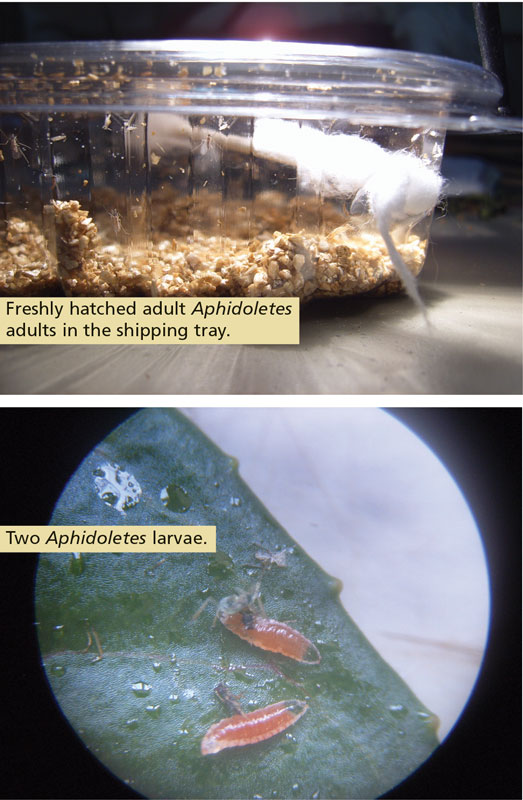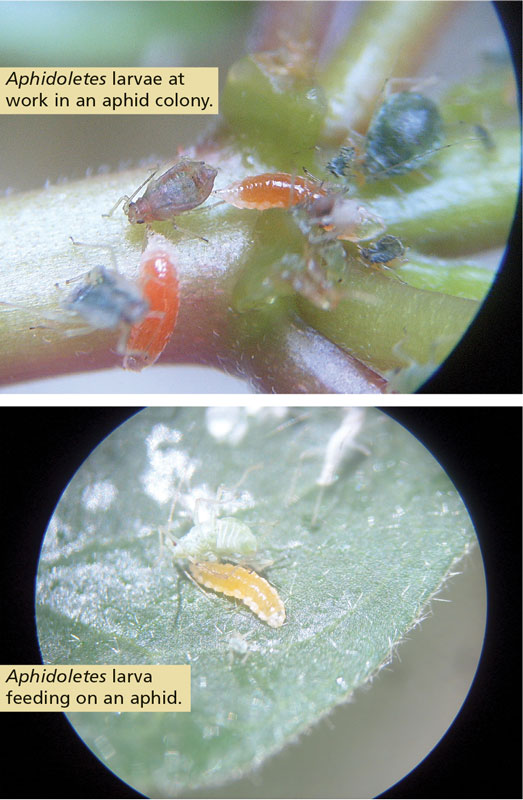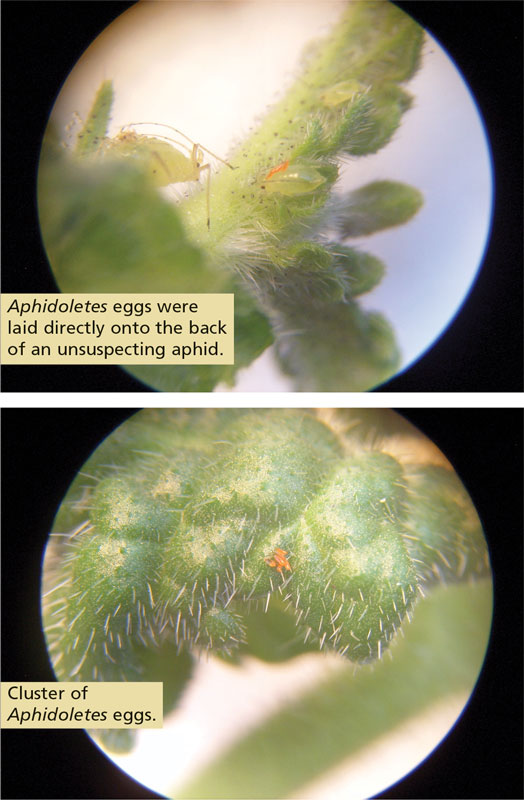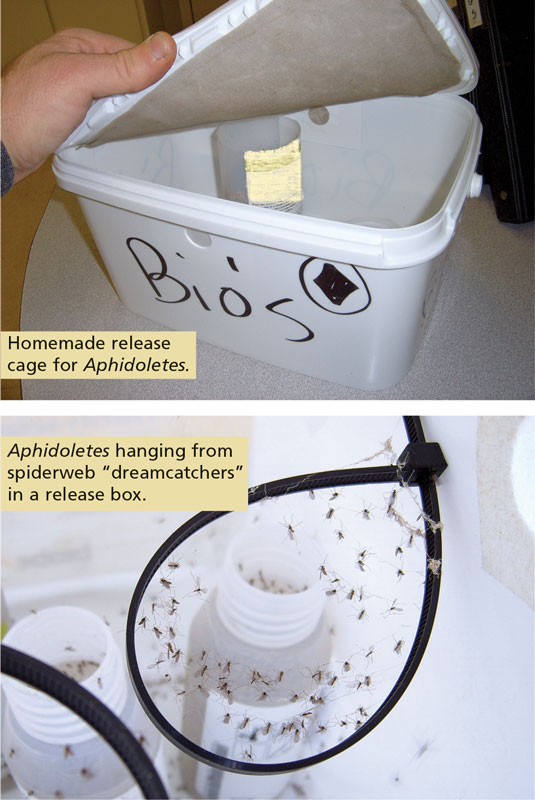6/1/2019
Biocontrol Anecdotes: Aphidoletes
Albert Grimm

 Aphidoletes aphidimyza, the aphid midge, was one of the first biocontrol agents (BCAs) to be available cheaply and in abundant quantity. We’ve known for a long time that they work really well as long as everything is to their liking. These little orange “worms” are a force to behold in an aphid colony. Aphidoletes are happy during mid-summer months when days are very long and temperatures are warm. For the rest of the year, they generally prefer to hibernate. Trying to convince them otherwise has given me a very long and steep learning curve.
Aphidoletes aphidimyza, the aphid midge, was one of the first biocontrol agents (BCAs) to be available cheaply and in abundant quantity. We’ve known for a long time that they work really well as long as everything is to their liking. These little orange “worms” are a force to behold in an aphid colony. Aphidoletes are happy during mid-summer months when days are very long and temperatures are warm. For the rest of the year, they generally prefer to hibernate. Trying to convince them otherwise has given me a very long and steep learning curve.
I still don’t pretend to understand this BCA entirely. The more I learn about the behavior of this insect, the more I feel like I’m watching a bizarre alien universe. I hope that this story helps you to understand some of the thought processes that are required to understand the concept of managing bugs with bugs.
I was growing kalanchoe when I had my first trial-and-failure experience with Aphidoletes. This crop was easily damaged by the chemical arsenal available in those days and aphids were a persistent problem. Aphidoletes had a reputation for some tolerance to pesticide residues and we hoped that we could integrate them with some of the more benign chemical controls.
Synthetic pyrethroids appear to include the most persistent biocontrol disruptors among pesticides and we began by avoiding these insecticides altogether. A few months later in early summer, we noticed that naturally occurring populations of Aphidius and Aphidoletes began to migrate into the greenhouse from surrounding fields. The challenge was to extend this control into the rest of the year.
We knew that Aphidoletes needed 16-hour days and temperatures above 21C (69F) to reproduce and we could easily provide these conditions in our stock production. So we bought a few trays of Aphidoletes pupae, put them out on a greenhouse bench and waited.
needed 16-hour days and temperatures above 21C (69F) to reproduce and we could easily provide these conditions in our stock production. So we bought a few trays of Aphidoletes pupae, put them out on a greenhouse bench and waited.
Nothing happened. After the third attempt, we noticed a procession of garden ants moving to and from the trays. The ants were busy carrying our Aphidoletes pupa to their nests. These ants had found the proverbial jackpot.
Ant-proofing our installation didn’t give us more reliable results; we realized that we had to dig much deeper. We didn’t know much about the lifestyle and preference of these insects, and we needed to learn more.
Linda Gilkeson was one of the pioneers working with this BCA and she had published her fundamental work in the 1980s, but there was more to the story. We had to understand the typical behavior of these predators. It was clearly not feasible to use Aphidoletes as a biological pesticide outside of the summer months, but it seemed promising to regularly introduce very modest numbers in the hope that they would use their excellent search capabilities to find small aphid colonies before we could notice them in the crop.
The adults of Aphidoletes aren’t predatory; only wingless larvae eat aphids. The adults fly and search, but they only feed on honeydew. Before any aphid can be killed, adult Aphidoletes midges have to mate and then lay eggs.
This is where things got weird. How do you encourage a bug to mate? The mating behavior of Aphidoletes reads like a low budget sci-fi movie: after hatching from the pupae, the female midges fly and search for the scent of a pheromone coming from the webs of female spiders. The female midge hangs herself by her front legs from one of the silk strands in the web, while taking care not to alert the spider to its presence. The midge then distributes her own pheromones to attract a male. The insects copulate in the spider web, and unless the spider is very alert, the female flies off and looks for aphid colonies where to deposit the fertilized eggs.
We began to integrate the night life preferences of these midges into our methods:
 • We stopped cleaning spiders and their webs from our greenhouse, even though this caused considerable discomfort for the arachnophobes among us.
• We stopped cleaning spiders and their webs from our greenhouse, even though this caused considerable discomfort for the arachnophobes among us.
• We turned off HAF fans for some time just before and just after sunset. Strong air circulation disturbs the delicate plumes of aphid or spider scent and it makes pheromone navigation difficult for the adults.
• Anecdotal wisdom has it that sunset must be gradual for these insects to get into the mood of mating or laying eggs. So, instead of running our HID lights to extend the end of the day, we began to turn them on in the middle of the night to extend the morning.
Still, the results were rather mixed and mostly underwhelming. In order to increase the chances of mating and in an attempt to keep the greenhouse spiders from getting fat on our bios, we decided to create a single’s bar for bugs out of old plastic pails. We made rings from zip-ties and collected spider webs in the greenhouse. Then we fixed those rings to the inside of the release box. I did get funny looks when I went through the greenhouse looking for spiderwebs for my dreamcatcher …
We knew that Aphidoletes are immobile during daylight hours—they prefer to hang still in the spiderweb and wait for sunset. Consequently, we equipped the release boxes with a source of food for the adults and placed them near a window in our office to make sure that the insects experienced natural sunset. When our spiderweb installation was crowded with freshly emerged mothers in waiting, we thought bingo! We gave the adults time for a night of romance.
Some of the midges didn’t survive those nights; many were dead on the floor of our release cages. Some shipments hatched, but didn’t survive for more than 12 hours. This was a lesson in quality control. Previously, when we released directly into the greenhouse, we could merely check whether the pupae were empty and whether the adults had hatched, but we had no means of assessing how many survived long enough to lay eggs. We suspect that pupae coming from long periods of cooling don’t produce many viable adults.
With each of these additional steps, our control failures became less frequent and we managed to keep aphid populations below colony-forming numbers much longer into the season. Still, aphids remain a problem in some crops, particularly in spring hanging baskets. We now suspect that Aphidoletes (and other BCAs) simply don’t like certain crops, such as calibrachoa—perhaps the plants are irritating or even toxic to the predator. Quite possibly the aphids are able to protect themselves with lethal or deterrent chemicals, which they extract from the plant. Available research into these details is scant or not available at all.
We were able to observe one reason for control failure: the little orange larvae are rather clumsy; they have trouble holding on to smooth surfaced leaves such as fuchsia. Aphid colonies are typically found near the youngest growth, which overhangs the rim of a hanging basket. We watched Aphidoletes larvae slip from the overhanging foliage and fall onto the crop underneath. We had very good aphid control on these floor crops. GT
Albert Grimm is head grower for Jeffery’s Greenhouses in St. Catharines, Ontario, Canada.